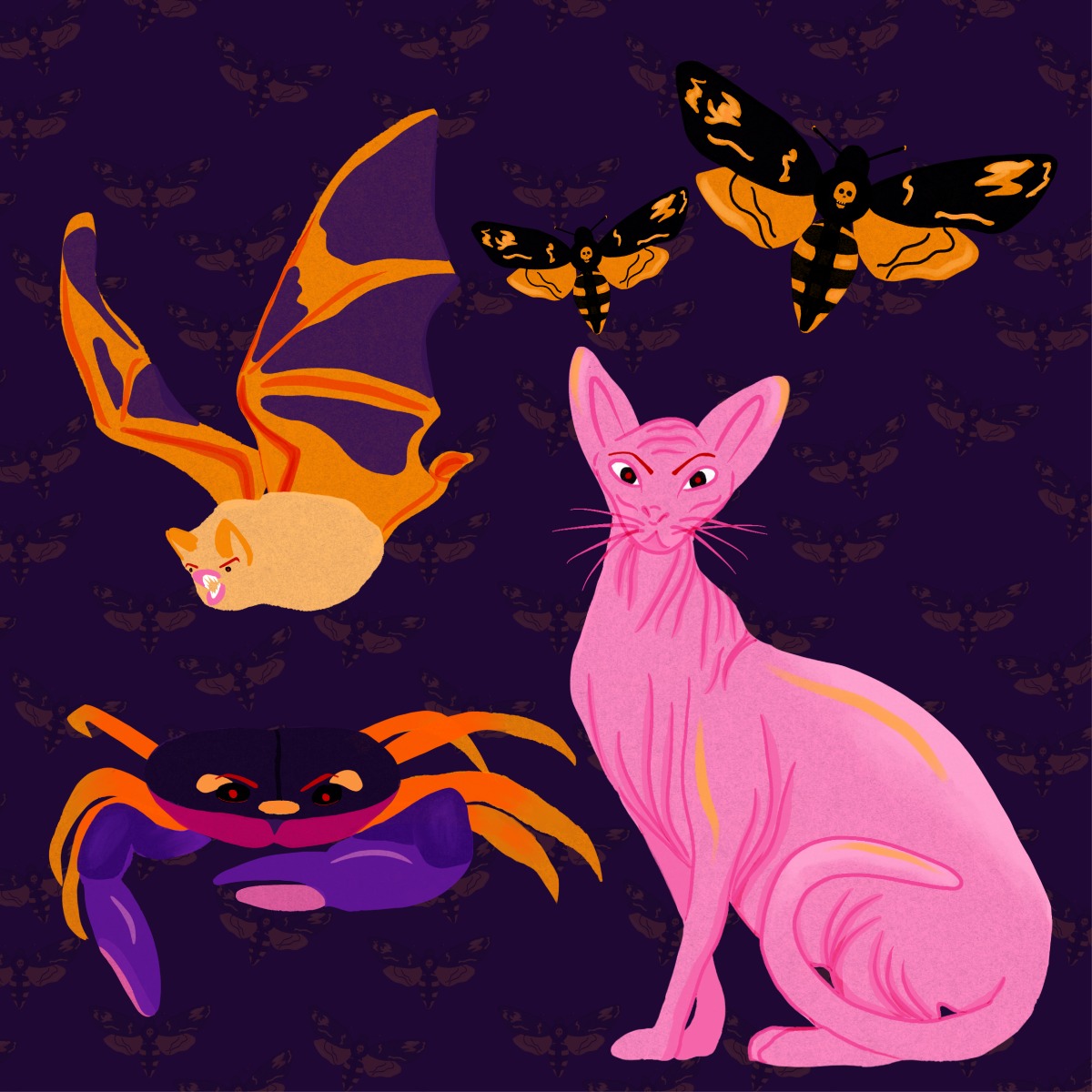When someone says Halloween-themed animals, most people will think of the classics—cats, bats and rats. Also spiders, but that doesn’t rhyme. These animals are tied to the scary spaces, characters and settings and are often featured in set design for anyone fixing together a spooky haunted house, but what are some unique animals which might appropriately fit Halloween’s weird and creepy vibes?
Sphynx cat (Felis catus)
The black cat is often associated with curses and witches, but it’s just a regular cat color. Adding a white patch can turn a black cat into a distinguished little gentleman who is just as cute and fluffy as any other cat.
Now, a sphynx cat is one that people already dislike due to the overwhelming amount of visible skin. The skin only adds to their devilish look, with the folds giving their face an almost evil demeanor. This cat is rare and truly only owned by women who’ve mysteriously come across the $15,000 it costs to get one.
Honorable mentions: Donskoy—another hairless cat from Russia. An Oriental shorthair European cat which has a long, rugged face with the ears of a bat.
Halloween moon crab (Gecarcinus lateralis)
It has Halloween in the name! This versatile crab can be a tasty treat or a tricky pet. They have bright color patterns of orange, purple, red and black, making it a distinct decoration for the year-round spooky season.
Honorable mention: Though not a crab, the python breeding world has attempted to harness the morphs of pythons to create color patterns. The albino piebald ball python has Halloween energy and sometimes has the magic image of a jack-o-lantern.
Painted bat (Kerivoula picta)
This tiny monster is not as fearsome as the better-known vampire bat, but is unique in its stark orange coloration. Like other small bats, this pocket-sized mammal has a wingspan of 18 to 30 centimeters and weighs on average five grams.
Though they are bats and Halloween colored, these bats are not what most would consider fearsome. These bats are native to Bangladesh and sleep in places like banana leaves in colonies of two to six bats. Like many bat species, they subsist on a diet of small insects and are endangered. This species is described as data deficient, and little is known about them.
Honorable mention: Vampire bats. They hop and bite.
Vampire squid (Vampyroteuthis infernalis)
This is the perfect animal for those afraid of all life in the vast void of the ocean. In pitch darkness, almost everything in the abyss zone can be considered honorarily on this list. The vampire squid is fun for its name, unusual shape and lack of being a squid. Its scientific name translates to vampire squid from hell, meaning there were some strong feelings from the people who saw it. Just looking at this thing might make one wonder what this creature hunts. The answer is nothing. It actually filters waste that floats down, feeding on marine snow. This animal is endangered due to its diet and the pollution of microplastics.
Honorable mention: Anything down there, or goblin sharks.
Death’s head hawkmoth (Acherontia atropos)
Moths—the cryptic cousin of the butterfly—are often known for their love of flickering light bulbs in a musky dark room. This moth is uniquely spooky. Its common and scientific name originate from the eerie, skull-shaped pattern on its thorax. The symbol of a skull is often used in reference to death or an omen of dying. This month has been recognized for its horrific symbolism, starring in haunting films like Jonathan Demme’s The Silence of the Lambs and Terence Fisher’s Dracula. Though not the most fearsome species on this list, this moth lets out a ferocious squeak when threatened. You’ve been warned!
Honorable mention: Monarch butterfly.
Marbled orb weaver (Araneus marmoreus)
This is also known as the pumpkin spider. For all those seasonal spider lovers—and haters—the marbled orb weaver is a sight to see. It gets its nickname from its appearance, with a large, orange abdomen like that of a fat pumpkin. Funnily enough, this spider gets to a large size in the fall, just in time for the season. With how bright this spider is, you won’t be able to miss spotting one if you ever come across it on a hike. This spider is native to North America, so you may find it this Halloween season.
Honorable mention: Black widow. She is goth, not Halloween.
Pumpkin patch tarantula (Hapalopus sp. Colombia)
No, these are not a species of tarantulas that live in pumpkin patches. This spider is considerably small for a tarantula and is sought after for its uniquely brilliant orange and deep black pattern. It flicks hair—similar to other New World tarantulas—but is smaller and less effective than larger types.
These are terrestrial species native to Columbia. They burrow and are solitary species. They are poisonous—as if you need another reason to stay away—though they are not considered life-threatening. As a pretty standard tarantula, you can find most information about them in care sheets and on pet websites. Take one of these pumpkin patch tarantulas if you dare.
Honorable mention: Any tarantula.
You’ll be happy to know we share a planet with these fascinating, sensational creatures of the night—and day. Some of you will even be happy to find the ones you can take home for those who want the Halloween spirit 365 days out of a year.






